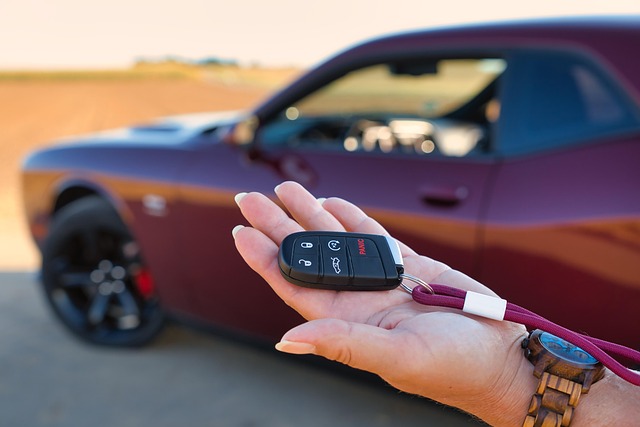Looking to register your car in California? This comprehensive guide walks you through the entire process, ensuring a smooth experience. From understanding crucial registration requirements to gathering essential documents, this step-by-step tutorial covers it all. Learn about the critical dmv vin verification step and master the art of completing your registration application efficiently. Get ready to hit the road legally!
- Understand California Car Registration Requirements
- Gather Necessary Documents for DMV Visit
- Perform Vehicle Identification Number (VIN) Verification
- Complete Registration Application at the DMV
- Pay Registration Fees and Obtain License Plate
Understand California Car Registration Requirements

Before registering your car in California, it’s crucial to understand the state’s specific requirements. The California Department of Motor Vehicles (DMV) mandates that all vehicles entering the state be properly registered and insured. This process involves several steps, including a comprehensive vehicle inspection and verification of the vehicle’s identification number (VIN). The DMV conducts a VIN verification to ensure the car’s history is clean and it hasn’t been reported as stolen or damaged beyond repair.
Additionally, you’ll need to provide proof of insurance, valid identification, and the necessary documentation such as the title and sales agreement. For convenience, many Californians opt for a mobile VIN inspection or verification service, which allows them to complete these steps from the comfort of their homes. This streamlined approach not only saves time but also ensures that your car registration process is hassle-free.
Gather Necessary Documents for DMV Visit

Before heading to the DMV, make sure you have all the required documents for a smooth car registration process. One crucial piece is the Vehicle Identification Number (VIN) verification. This step involves obtaining a valid VIN inspection, which can be done through various methods, including a mobile vin verifier or even a simple online check. Always ensure the VIN belongs to your specific vehicle and matches the details on your registration documents.
Having these documents ready will save you time at the DMV: your driver’s license, proof of insurance, title certificate (or lien holder information), and any required fees. For older vehicles or those with unique histories, additional documentation might be needed, so it’s good to check with the DMV in advance. A mobile vin inspection can be particularly handy for these scenarios, as it provides immediate results and convenience.
Perform Vehicle Identification Number (VIN) Verification

Before submitting your car for registration, performing a Vehicle Identification Number (VIN) verification is a crucial step in California. This process involves confirming the vehicle’s authenticity and history through a comprehensive check using its unique VIN code. You can opt for a traditional dmv vin verification or consider more convenient options like mobile vin verification and vin inspection services that come to your location, making it hassle-free.
During the VIN verification, various aspects of the car’s history will be scrutinized, including its ownership records, accident reports, and any outstanding issues. This step ensures that you’re registering a legitimate vehicle with no hidden problems. It’s essential to choose reputable service providers offering accurate and reliable mobile vin inspection to guarantee a smooth registration process for your California vehicle.
Complete Registration Application at the DMV

To begin the registration process for your car in California, you’ll need to complete a Registration Application at your local Department of Motor Vehicles (DMV) office. This form requires several essential details, including your personal information and vehicle specifications. Ensure you have all the necessary documentation, such as proof of ownership, before heading to the DMV. One crucial step is the DMV vin verification, where they’ll cross-check your Vehicle Identification Number (VIN) with their records to ensure the car’s history aligns with the information provided.
A convenient option many California residents opt for these days is using a mobile vin inspector or mobile vin verifier. These services allow you to get your VIN checked remotely, saving time and effort. However, having this done at the DMV guarantees accuracy and ensures all legal requirements for car registration are met, which is essential when navigating California’s regulations.
Pay Registration Fees and Obtain License Plate

After completing your vehicle’s registration application at the California Department of Motor Vehicles (DMV), it’s time to settle the fees associated with registering your car. This typically includes a base fee and, in some cases, additional charges based on factors like vehicle type or emissions standards. Once you’ve paid the required amount, the DMV will issue you a registration certificate, which confirms that your vehicle is legally registered in California.
As part of this process, you’ll also need to obtain license plates for your car. This usually involves taking your registered vehicle and a valid driver’s license to a designated DMV location where they will attach the plates to your vehicle. Alternatively, some services offer mobile vin verification using a mobile vin verifier, allowing you to complete both steps, including a vin inspection, from the comfort of your own home. Ensure that your plates are displayed properly according to California regulations for optimal safety and legality on California roads.
Registering a car in California involves understanding key requirements, gathering essential documents, and completing necessary procedures like DMV VIN verification. By following these steps—from identifying your vehicle’s unique Vehicle Identification Number (VIN) to paying registration fees—you’ll be on your way to securing the legal right to drive your new or transferred vehicle within the state. Remember, proper registration ensures compliance with California regulations and provides vital information for road safety and emergency services.
